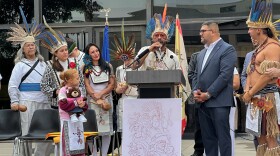Mexican artist María Vargas is standing inside La Grua Center in Stonington behind a table covered with paint brushes and bottles of acrylic paint.
There’s also a ceramic bowl filled with dried insects that look like peppered pebbles.
“Grana cochinillas”—or cochineal insects—were the key artistic tool for Vargas’ adult art workshop in late September as an artist-in-residence with Expressiones Cultural Center. They are tiny, round scale insects native to subtropical Central and South America. You can find them on the nopal or prickly pear cactus.
“My goal with this workshop was to teach about a natural material that comes from an insect and how it is very sensitive to different conditions,” Vargas said in Spanish. “But that same sensibility brings out the most intense colors.”
Surrounded by her students, Vargas crushed the sun-dried insect in her palm, releasing a deep red liquid onto her hand.
At first glance, it may look like blood, but it’s actually carminic acid, a red chemical that female cochineals and their eggs produce to deter insect predators. It’s also the key ingredient for carmine, a red pigment used to dye clothing, cosmetics and food.
“We will see in this group that [red] color will change because the pH of each of us is different,” Vargas told her students.
The red color changes because of the acidity of your sweat, Vargas explained. She added a bit of her spit to the chemical. Within a few minutes, the red changed to a lighter shade of pink.
Vargas said the way cochineal dye interacts with natural acidity opens the doors to more possibilities.
One of the students used a mortar and pestle to grind the cochineals to a fine powder. Vargas took that powder and made small piles of it on white paper. Then, she started to experiment.
She mixed the piles of cochineal powder with mandarin orange, hibiscus tea, acrylic paint, olive oil and even a Lysol cleaning spray.
Soon enough, the paper was covered in various shades of red, brown, purple and pink.
“So the art and the science work together,” Vargas told her class. “What I [intend] is that you experiment in this workshop, to know the material and experiment and see what happens.”

A historical dye for conceptual art
The red cochineal pigment dates back to the times of the Maya and Aztec peoples, who used it in rituals and traded it throughout Central and South America, according to the .
Other indigenous groups throughout the Mexican regions of Puebla, Tlaxcala and Oaxaca used the red paint pigment to dye cloth, feathers and murals.
After the Spanish conquest in the 16th century, the red dye was traded so far and wide, its red pigment became an international symbol of power.
Cochineal red was used in the scarlet robes of Catholic cardinals and in the English redcoats that come to mind when you think of the American revolution.
“In the time of the colony, it [was] almost the same price as gold,” Vargas said.
It was Mexico’s second-most valued export, according to .
The historical and natural concepts around cochineal dye piqued Vargas’ interest for the idea behind her workshop, because those concepts are the very things that piques Vargas’ interests as an artist.
Vargas is a multidisciplinary artist who likes to focus on themes of the natural world. She likes to use different mediums to conceptualize those themes in her artwork.
For example, she has used dead butterflies and scorpions that she has found back home in Mexico in her mixed media paintings.
For the workshop, Vargas said her focus wasn’t just on the material, but working around themes regarding natural pigments and Mesoamerican culture.
“It’s not just about painting. The conceptual part is also important,” Vargas said.

An open invitation to play with paint
Vargas’ class settled into a steady rhythm as participants went off to experiment with the cochineal dye.
“By experimenting with [cochineals], you can discover a whole range of colors and ask yourself, ‘what can I do with this?’” Vargas said.
Vargas said cochineal natural dye can be easily found at some art stores and online.
“You can experiment with things you have at home,” Vargas said. “We used fruit and cleaning supplies. You can also use rubbing alcohol and beer. Some people also use egg yolk.”
The wheels were already turning for one of the painters, Nora O’Farrell of Westerly, Rhode Island.
“It makes me want to go home and play with my coffee grinds,” O’Farrell said.
Stephanie Tuttle of Stonington said the workshop opened her eyes to mediums from different cultures.
“I like to experiment myself,” Tuttle said. “So being exposed to new styles, new methodologies and color stories is really a fun exercise.”
Barbara Block of Mystic said though she found the workshop interesting, she doesn’t see herself adding cochineal insects to her practice, for now, anyway.
“Sometimes you need to let these things sink in a little bit,” Block said.
Sink in like the cochineal red dye, which needs a little bit of time to sit in its experimental mixture before it reveals a new unique color for painting.





